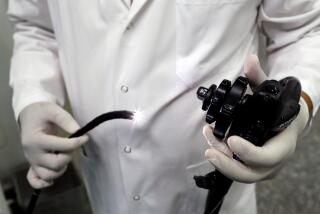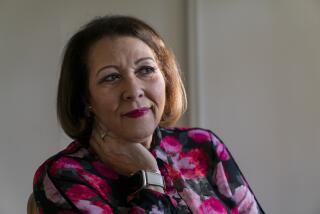Cancer screening: What could it hurt? A lot, actually
It seemed like a good idea at the time.
In 1984, Japan began screening the urine of 6-month-old infants for neuroblastoma, the most common type of solid tumor in young children. The test was simple and could show signs of cancer long before clinical symptoms arose.
Hundreds of infants went through the ordeal of diagnosis and treatment, but it didn’t reduce the number of tumors, including deadly ones, found later. Almost none of the tumors caught by screening turned out to be dangerous -- and more of the screened children died from complications of surgery and chemotherapy than from the cancer itself.
In 2004, health officials ended the program.
The United States is grappling with the same type of problem today. After decades of focus on the upside of cancer screening, public health experts are increasingly reevaluating the wisdom of administering routine cancer screening tests to millions of asymptomatic people.
Though screening certainly saves lives, recent studies make it clear that it also leads to biopsies, surgeries, chemotherapy and radiation -- even some deaths -- that otherwise would not have occurred.
That screening has a downside is not easy to accept, as evidenced by the furor over this week’s recommendation from the U.S. Preventive Services Task Force that most women wait until age 50 to start routine mammograms, and then get them only every other year.
Though the decision was based on new scientific evidence that many more women are harmed than helped by annual tests starting at age 40, it was swiftly attacked by physicians and policymakers who said they would ignore it.
The message that we’re over-screening for cancer isn’t necessarily a welcome one to the American public either.
A whopping 87% of U.S. adults believe that routine screening is “almost always a good idea,” and 74% believe early detection saves lives “most or all of the time,” according to a 2004 survey in the Journal of the American Medical Assn.
Most said they’d continue to get their screening tests even if their doctors advised against it.
Indeed, in the days after the task force released its mammogram recommendations, breast cancer survivors railed online against what they saw as the notion that their lives were not worth saving.
Part of the outcry stems from the fact that so many people know someone who was diagnosed with breast cancer in her 40s and appeared to respond to early treatment. It’s natural to think of those women as the ones who would be hurt by a reduction in screening, psychologists say.
We’re not as well equipped to weigh the risks and benefits of the population at large.
“We think, ‘I’m sure glad my sister or my best friend got that done,’ ” said Julie Downs, director of the Center for Risk Perception and Communication at Carnegie Mellon University in Pittsburgh.
Also complicating matters is that it’s easy to identify cancer survivors whose tumors were caught by screening, but it’s nearly impossible to put a face on the woman or man who is hurt by over-screening.
Patients are also reluctant to give up on the idea that they can control their medical destiny through proactive measures, said Nancy Berlinger, a healthcare bioethicist at the Hastings Center, a research institute in Garrison, N.Y.
“Anything that suggests that early detection might not save lives is going to be deeply disturbing,” she said. “It suggests that we can’t do much to help ourselves.”
The public’s attachment to screening also reflects its faith in high-tech medicine, said Dr. Len Lichtenfeld, deputy chief medical officer of the American Cancer Society in Atlanta.
“They want to believe that the new technology is the better technology,” he said. “Sometimes it is -- sometimes it isn’t.”
The idea that detecting cancers early makes them easier to treat has been around since at least the 1930s, when doctors began advising women to conduct breast self-exams.
“That philosophy sounded right, so screenings were implemented,” said Dr. Therese Bevers, medical director of the Cancer Prevention Center at the University of Texas M.D. Anderson Cancer Center in Houston.
And in many cases, that strategy works. The American Cancer Society credits widespread use of mammograms for a 2% annual decrease in breast cancer deaths since 1990. Pap smears have slashed deaths from cervical cancer by more than 70% since they were introduced in the 1940s.
But finding cancers that respond to early treatment is only one of the potential outcomes from a screening test. Many tests produce false positives, prompting additional tests that can be invasive, expensive, time-consuming and anxiety-inducing.
A study published this spring in Annals of Family Medicine found that 60% of men and 49% of women had gotten at least one false positive during three years of routine screenings for ovarian, prostate, lung and colorectal cancer. As a result, 22% of those women and 29% of those men had an invasive diagnostic procedure, the study found.
Other screening tests produce false negatives, giving patients and their doctors the incorrect impression that they have nothing to worry about.
Some detect aggressive cancers whose outcomes aren’t improved by early detection.
And some identify small cancers that grow so slowly they’d never compromise a patient’s health. Many would even go away on their own.
Statisticians and epidemiologists know this for a fact. The problem is, there’s no way to tell which of the tumors are dangerous and need to be treated and which are harmless and would be best left alone. So all of them get treated, often aggressively. The medical establishment calls this overdiagnosis.
“Overdiagnosis is the hardest thing to explain to people,” said Dr. Stephen Taplin, chief of the Applied Cancer Screening Research Branch at the National Cancer Institute in Washington, D.C. “No individual woman can know if they’re overdiagnosed. They know they have cancer, and they’re scared to death. It’s completely justified.
“But if you look at people overall,” he added, “there are some people who suffered that scare unnecessarily. If they had never known about that cancer, it wouldn’t have affected their life.”
Such nuances weren’t considered when screening tests were implemented. Many were introduced before their effectiveness had been established though clinical trails. At the time, doctors didn’t see the need. But experience has prompted them to reconsider.
Take the cancer antigen 125, or CA 125, test that has been used to screen for ovarian cancer. Women with the disease often have higher blood levels of this protein, so it seemed to make sense to check for it in asymptomatic women.
The test was never widely adopted and is no longer recommended for women at average risk, because other conditions, such as diverticulitis and endometriosis, can also boost CA 125 levels. And some patients with the disease have normal levels of the protein.
Many doctors are backing off the prostate-specific antigen test to screen for prostate cancer now that two influential studies published this year found that early detection offered little to no benefit in long-term survival. But the PSA tests did prompt aggressive treatment that sometimes left men impotent or incontinent.
Some guidelines, including those for cervical cancer, have been amended to reflect a better understanding of cancer biology. The American College of Obstetricians and Gynecologists this week suggested that most women get Pap tests less frequently because it’s known now that cervical cancer progresses slowly, and abnormal cells often resolve on their own, especially in younger women.
Despite outcry from patients who equate reduced screening with reduced care, it makes no sense to ignore scientific data that happen to be unpalatable, said Dr. George Sawaya, a researcher at UC San Francisco whose studies helped prompt the change in Pap test guidelines.
“It would be much more of a travesty if we didn’t change our guidelines in response to new information,” he said.
Times staff writer Shari Roan contributed to this report.







